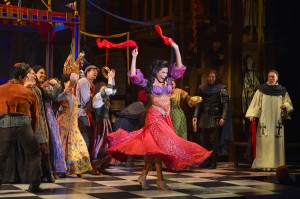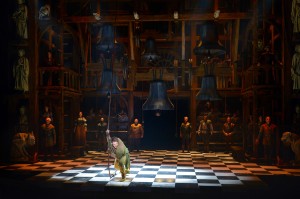‘Hunchback’ Fills The Stage at La Jolla
The Hunchback of Notre Dame, a new musical version of Victor Hugo’s Gothic romance now in premiere at the La Jolla Playhouse, is an industrial-strength stage show, an invigorating evening of theatre with no irritating aftertaste and bright prospects.
Since it is a project of the Disney Theatrical Group (in association with the LJP and the Paper Mill Playhouse in New Jersey), the shop probably will be polished and moved to Broadway for a substantial run in one of the Disney empire’s houses.
These Alan Menken-Stephen Schwartz songs are mostly from the animated 1996 Disney film but the Peter Parnell book is a muscular shuffling of plot elements that successfully provides an urgent theatricality.
Hugo’s bulky, pungent 1831 novel Notre-Dame de Paris has survived because of the haunting central character: Quasimodo, the twisted grotesque who inhabits the vast stone towers of Notre Dame Cathedral and rings the gigantic bells that measure the days of medieval Paris.
In Parnell’s version, he’s a pitiful recluse, hidden from the world by the arch-deacon of Notre Dame, Claude Frollo, who has raised this, his wastrel brother’s bastard, as a cross to bear while ascending through the church hierarchy. Frollo treats the inarticulate Quasimodo with stern but tolerant fondness, chiding the boy for his habit of conversing with the stone carvings of saints and gargoyles that are his only companions.
From his perch high in the gothic arches, Quasimodo watches the life of the Paris streets and dreams of claiming his humanity. When he does venture forth, though, it is as Frollo has predicted. The mob, crazed by the annual Feast of Fools debauch, falls upon him as a freak to be tormented. He is saved, not before his public humiliation, by a compassionate captain of the guard and, most significantly, a big-hearted gypsy street dancer.
This girl Esmeralda is the peg upon which the story hangs. She bedazzles Quasimodo, wins the heart of the Captain and stirs agonies of lust in Frollo, plenty of plot room for action and emotion.
The songs – about otherness, heaven and hell, hope, sanctuary – are sturdy and rousing. The staging, by Scott Schwartz, the lyricist’s son, is endlessly energetic and often ingenious, a superb use of just 17 actors to suggest an entire medieval tapestry. Give director Schwartz another half-dozen actors and he might start an empire.
The wonders of special effects and animation can stuff a movie scene to bursting. Schwartz does it with a glorious heritage of stage trickery. Disappearances? Flash powder. A graveyard yawns? Actors and cloth are the tombstones. There’s even a song that’s not really necessary but probably will remain because it allows for an ancient trick whereby a body can seem to carry its severed head on a plate.
Since dozens of characters must be juggled by a handful of actors, quick and vivid wins the day. Of the five leading roles, two are dominant: The majestic Patrick Page as the tyrannical Frollo, a villain of surprising nuance, and Erik Liberman, as the nimble, broody street harlequin who speaks for the vox populi.
Ciara Renee as Esmeralda and Andrew Samonsky as her captain are bright and handsome but lagging in charisma while Michael Arden’s Quasimodo lacks consistency, bulging emphasis in too many directions and never settling upon, for example, a voice.

Ciara Renee is Esmeralda in La Jolla Playhouse The Hunchback of Notre Dame, with Patrick Page, right, as the Arch Deacon Frollo. Kevin Berne Ohoto
The other main character – 15th Century Paris itself – also is indistinct. The contrasted wealth and squalor of a medieval city isn’t there. Alexander Dodge’s handsome scenery is sturdy and bold in texture, enhanced by the way Schwartz’ actors swarm over and through it. Despite, however, the overhead array of giant bells, the Cathedral of Notre Dame never emerges. And there’s no real sense of being above the city. The famed array of religious statuary, played by draped actors, is a muddled effect.
And that’s too bad. Parnell’s script uses a group narrative technique, by people and (in Quasimodo’s head) those statues, to give the show more of a literary air than some adaptations achieve, but the combination of scenery, staging and script doesn’t ultimately jell.
There are gaps in the story telling, especially as the pace picks up toward the end. When soldiers charge the cathedral in violation of the sacred sanctuary tradition, Quasimodo stops them with a cauldron of melted lead, marvelous stagecraft if inadequately explained. And Esmeralda’s fate seems all too like the last act of an opera.
Some of the scenery is alive, soaring choir lofts stuffed with 32 live singers of the San Diego ensemble Sacra/Profana, performing with skill and enthusiasm Menken’s channeling of heavyweight influences from Rameau through Bach and Carl Orff to Ligeti.
The pit orchestra of 15, conducted scrupulously by Brent-Alan Huffman, and the endless parade of marvelously detailed costumes by Alejo Vietti also testify to the serious aspirations of this production, which approaches the job with proud and loving handcraft and is rewarded with resonant success.
Continues on the Weiss Theatre stage at 7:30 p.m. Tuesdays and Wednesdays; 8 p.m. Thursdays-Saturdays; and 2 p.m. Saturdays and Sundays through Dec. 7, 2014.

Welton Jones has been following entertainment and the arts around for years, writing about them. Thirty-five of those years were spent at the UNION-TRIBUNE, the last decade was with SANDIEGO.COM.



